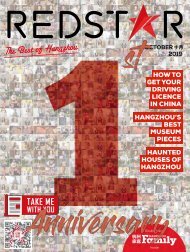Create successful ePaper yourself
Turn your PDF publications into a flip-book with our unique Google optimized e-Paper software.
/ CULTURE // 广 告 • 文 化
IS CHRISTMAS
TOO WRAPPED IN
MATERIALISM?
By Dr Rob Burton
Christmas in China is a strange
affair. The trappings of
the festival are all around
festooning China’s shops,
offices, and public spaces. It’s the
usual tat: glitter, greenery, ribbons,
images of Santa, reindeer, Santa
hats, and snowy vistas. The popular
Christmas songs are playing on a
loop in all the big stores and cafés like
Starbucks from November onwards.
But who is it for? Surely not for the
average Chinese man and woman
on the street? They have a veritable
smorgasbord of festivals of their own
to choose from, and indeed their own,
immensely popular and huge Spring
Festival is arriving very soon when
they welcome their own New Year in.
The Chinese Spring Festival, which
incorporates Chinese New Year,
takes place over fifteen days or
more and most Chinese people
will take a month off work, so why
they are in thrall of the Christian
festival Christmas takes some
thinking about. Chinese New Year
is the longest and most important
festivity in the Chinese calendar.
The origin of Chinese New Year
itself originates as far back as -2300
BC and gains significance because
of several myths and traditions.
Whereas, what we Westerners know
as Christmas is barely 1,600 years old.
The modern Western Christmas also
shares a quite convoluted history
which is tied up in paganism and
burgeoning Christianity. It wasn’t
until about the 4th century that
Pagan and Christian leaders agreed
that the old festival of Saturnalia, held
in December with its concluding day
being December 25th, could also be
used as the celebration of the birth of
Jesus Christ. Thus, Christ’s birthday
was arbitrarily set as December 25th.
Apparently, the earliest Christmas
holidays were celebrated by drinking,
sexual indulgence, singing naked in
the streets (a precursor of modern
carolling), etc. – which sounds to me
a darn sight better to behold than the
spend-fest we indulge in nowadays.
Red also seems to be an important
colour for both festivals. Red
symbolises the blood of Jesus,
and at Christmas time, we see red
everywhere. Santa, thanks in part to
Coca-Cola’s advertising campaigns
of the 1930s, sports a bright bloodred
costume. Red is also a very
popular colour for Christmas
decorations, especially when
teamed with green, for example, the
green foliage and the red berries
of the holly bush which has both
pagan and Christian associations.
Red is the dominant colour of the
Chinese spring festival too. Red,
corresponding with fire, symbolises
good fortune and joy for Chinese
people. Red is found everywhere
during Chinese New Year and other
holidays and family gatherings. Red
clothes are bought and worn. A red
envelope with money inside is given
to children and friends. In China, the
red envelope is looked forward to
as intensely as a child in the West
waits for his or her presents on
Christmas Day. Red is also often worn
at weddings as it is the traditional
symbolic colour of happiness.
A Christmas in China tends to take
on a rather hollow meaning here.
I would argue, it has more to do
with the 'almighty dollar'—or Yuan

















